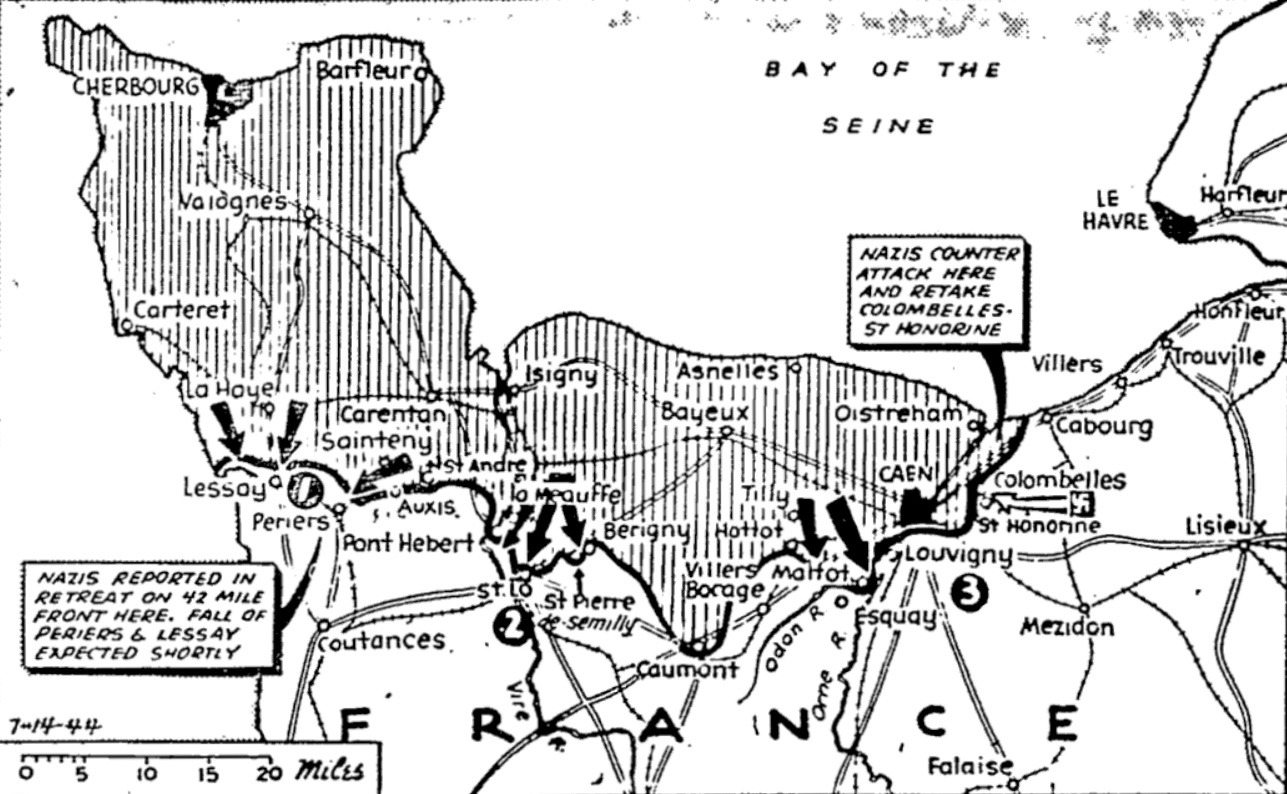The Pittsburgh Press (July 14, 1944)
Germans retreat in Normandy
U.S. 1st Army drives ahead along whole 42-mile front
By Virgil Pinkley, United Press staff writer
Nazis move back in Normandy before U.S. forces on the left side of the Allied line, with U.S. troops closing on Périers and Lessay (1), and driving to within less than a mile and a half of Saint-Lô (2). On the eastern side of the front, the British fell back slightly east of Caen (3).
Planes serviced fast by beachhead crews
Washington (UP) –
U.S. fighter planes are being serviced in 20 minutes on temporary runways in France, enabling them to complete four or five “spot missions” daily, the War Department said today.Ninth Air Service Command soldiers clamber over fighter planes as they roll in along 1,000-foot runways. They pump in several hundred gallons of gasoline and replace expended ammunition. This prompt and nearby service enables the fighters to operate over the battle zone without auxiliary gas tanks, the War Department said.
The air above the landing strips is often filled with 9th Air Force fighters “queueing up” to land.
SHAEF, England –
The U.S. 1st Army drove forward along its entire 42-mile Normandy front today in the wake of what was described officially as a general German retreat, capturing four villages and pushing within a little more than a mile of Lessay, the Nazi western defense anchor.
The grim and bloody battle for Saint-Lô, central base of the German line, raged unabated for Supreme Headquarters had no information later than front reports which said the American onslaught was resumed after a setback at the outskirts of the wrecked town.
Lt. Gen. Omar N. Bradley’s whole line hinged on Saint-Lô was swinging southward, shoving the stubborn Germans back through hedgerows, groves and marshes in slow but steady retreat.
U.S. control of the Atlantic coast was advanced as far south as the mouth og the river Ay, west of Lessay. U.S. forces won the area slightly southeast of Saint-Germaine-sur-Ay, two and a half miles northwest of Lessay, posing a new threat to that key town against which other forces were pushing down the road from La Haye-du-Puits.
Line straightened out
In the area above Périers, where the Americans were less than three miles from this stronghold. Gen. Bradley’s troops straightened out their line for a frontal assault on the town by capturing a number of strongpoints.
The hamlets of Es Aubris and La Vincenterie, about four miles south of Sainteny and flanging Périers to the northeast, fell to the advancing doughboys, along with Auxais, three miles southeast of Sainteny.
The Americans pushed forward 500 yards along the road from Sainteny to the village of Raids, four miles above Périers.
Late yesterday, the Germans tried to mount a counterattack toward Auxais, but were turned back handily without slowing down the American advance.
Road center taken
The road center of Les Champs-de-Losque, seven and a half miles northwest of Saint-Lô, fell to U.S. troops who probed further southward beyond it. From Les Champs, a valuable lateral road runs northward through Saint-André-de-Bohon to Carentan. Its entire length was now open to the Americans.
The only activity reported on the British section of the Normandy front was an attempt by the Germans to mass tanks west of Caen.
Highest ridge seized
A U.S. outflanking column seized the highest ridge overlooking Saint-Lô, hinge of the enemy line guarding the invasion roads to central Normandy, from the east, but a front dispatch from James McGlincy, United Press staff writer, said the frontal assault on the fortress town from the northeast had rolled to a temporary halt a little more than a mile away.
The Americans reached a village a mile from the edge of Saint-Lô in bloody fighting late yesterday afternoon, but later withdrew 200 yards to less exposed positions and dug in, apparently to await the arrival of other forces storming down from the north and northwest against lighter resistance for a general assault on the hilltop citadel.
The attack from the northwest was resumed this morning along both banks of the Vire River after a number of German rearguard counterattacks were beaten off during the night, Mr. McGlincy said. The northwestern column was about six miles from Saint-Lô, but steadily closing in, while another force was three miles away to the north.
Nazis gain near Caen
At the eastern end of the front, the Germans recaptured Colombelles and Sainte-Honorine, just east of Caen, in a counterattack while Lt. Gen. Sir Miles C. Dempsey’s British 2nd Army continued to regroup for the next stage of the Allied advance toward Paris, 120 miles east of Caen.
Front dispatches said the latest U.S. advances around Saint-Lô raised a treat of encirclement and made that stronghold, already pounded into rubble by artillery and bombs, untenable. Nevertheless, the garrison was not expected to capitulate or abandon the town until the Americans capture high ground to the south.
Gain highest ridge
The Americans gained the highest ridge overlooking Saint-Lô from the east with the capture of the village of La Barre-de-Semilly while other forces cleaned out all enemy snipers and strongpoints north of the Bayeux–Saint-Lô highway and advanced down the road to within a mile of the town. Already in American hands was similar high ground to the northeast.
Northwest of Saint-Lô, the Americans made faster progress. Crossing the Taute River, they pushed completely through the woodlands Bois de Hommet and captured the villages of Saint-Martin, Les Champs-de-Losque and Le Hommet-d’Arthenay, the latter six miles northwest of Saint-Lô.
On the north bank of the Taute, another column reached the outskirts of Auxais, a village three miles southeast of Sainteny.

